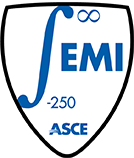Johns Hopkins University
Ryan Hurley
Problems
Our group strives to understand the inner workings of granular materials, rocks, and concrete subjected to static and dynamic mechanical loads. We are particularly interested in understanding how microscale deformation mechanisms such as breakage and flow give rise to macroscopic elastic, inelastic, and dynamic compaction behavior. Some driving questions include: (1) what microscopic deformation mechanisms occur across confining pressures during deformation of granular materials and rocks?; (2) what level of microstructural heterogeneity is needed to build robust, predictive mesoscale computational models of concrete?; (3) how heterogeneous are pore and particle dynamics during rapid compaction of granular materials and rocks?
Approach
Our research approach has three major thrusts: (1) using cutting-edge in-situ, multi-modal, and time-resolved x-ray measurements; (2) designing new mechanical devices to subject geomaterials to diverse, multi-axial stress states and characterize their behavior across length (nm to m) and time scales (ns to days); (3) developing new mechanism-based and mesoscale models.
Findings
Our findings in granular materials have illuminated force chains, grain rearrangements, breakage mechanics, and ultrasound wave propagation with unprecedented fidelity. Our findings in concrete have provided a new understanding of the behavior of concrete at millimeter length scales and have addressed fundamental questions regarding the level of microstructural heterogeneity needed in mesoscale models. Our mechanism-based models and micromechanical devices have provided new capabilities for simulating and studying geomaterials across length scales and strain rates with impacts on fundamental science and applications in geoscience and defense.
Impact
Our research has provided new insight into the micromechanics of granular materials, particularly through pioneering the combined use of synchrotron x-ray tomography and 3D x-ray diffraction to measure grain stresses in 3D sands during realistic loading conditions (uniaxial and triaxial compression). These findings have had an immediate impact on our fundamental understanding of granular mechanics. Our research on mechanism-based modeling, breakage mechanics, and granular mechanics across strain rates and pressures has also had important impact on the development of armor ceramics and modeling capabilities for impact and penetration predictions relevant to defense applications and planetary science.
Core Competencies
- Development of micromechanical testing devices to study mechanics from nanometer to centimeter length scales
- 3D and 4D image analysis of materials, including phase segmentation and digital image and volume correlation
- Design and execution of synchrotron x-ray experiments combining imaging and diffraction microscopy to study material deformation mechanisms
- Design and execution of dynamic experiments (drop tower, Kolsky bar, gas gun, etc.)
Current Members
- Mohmad M. Thakur (postdoc)
- Ye Tian (postdoc)
- Adyota Gupta (5th year Ph.D. student)
- Brett Kuwik (4th year Ph.D. student)
- Kwangmin Lee (3rd year Ph.D. student)
- Sohanjit Ghosh (2nd year Ph.D. student)
- Siddhartha Pittisapu (1st year M.S. student)
Recent Graduates
- Chongpu Zhai (postdoc, now at XJTU)
- Ghassan Shahin (postdoc, now at EPFL)
- Arthur Ding (M.S. student, now at APL)
- Surya Kollurii (M.S. student, now a Ph.D. student at Brown University)
- Ziheng Wang (M.S. student, now Ph.D. student at Purdue)
Collaborators
- Edward Ando (EPFL)
- Steven Hall (Lund University)
- Jonathan Wright (ESRF)
- Tejas Murthy (IISc)
- Darren Pagan (Penn State)
- Eric Herbold (LLNL)
- KT Ramesh (JHU)
- Todd Hufnagel (JHU)
- Lori-Graham Brady (JHU)
Funding Agencies
U.S. National Science Foundation, U.S. Army Research Office, U.S. Defense Threat Reduction Agency, U.S. Department of Energy, U.S. Air Force Office of Scientific Research.
Selected Publications
- B. Kuwik, G. Kim, C. Zhai, M. Daud, & R.C. Hurley* (2023). Roughness and humidity effects on contact, friction, and contact plasticity revealed by micromechanical testing and analysis, Tribology International, 178(B), 108075.
- M. Thakur, N. Axel Henningsson, J. Engqvist, P.O. Autran, J.P. Wright, & R.C. Hurley* (2023). On mesoscale modeling of concrete: Role of heterogeneities on local stresses, strains, and representa- tive volume element, Cement and Concrete Research, 163, 107031.
- G. Shahin & R.C. Hurley* (2022). Micromechanics and strain localization in sand in the ductile regime, Journal of Geophysical Research - Solid Earth, 127, e2022JB024983.
- B. Kuwik, M. Garcia, & R.C. Hurley* (2022). Experimental breakage mechanics of confined granular media across strain rates, International Journal of Solids and Structures, 259, 112024.
- C. Zhai, N. Albayrak, J. Engqvist, S.A. Hall, J. Wright, M. Majkut, E.B. Herbold, & R.C. Hurley* (2022). Quantifying local rearrangements in 3D granular materials: rearrangement measures, correlations, and relationship to stresses, Physical Review E, 105 (1), 014904.
- A. Gupta, R. Crum, C. Zhai, K.T. Ramesh, & R.C. Hurley* (2021). Measuring particle-scale 3D granular dynamics during rapid compression from 2D X-ray images, Journal of Applied Physics, 129: 225902.
- C. Zhai, E.B. Herbold, & R.C. Hurley* (2020). The influence of structure and forces on ultrasound transmission in granular media, Proceedings of the National Academy of Sciences, 117 (18), 16234- 16242.


